Ahsan A. Two Phase Flow, Phase Change and Numerical Modeling
Подождите немного. Документ загружается.

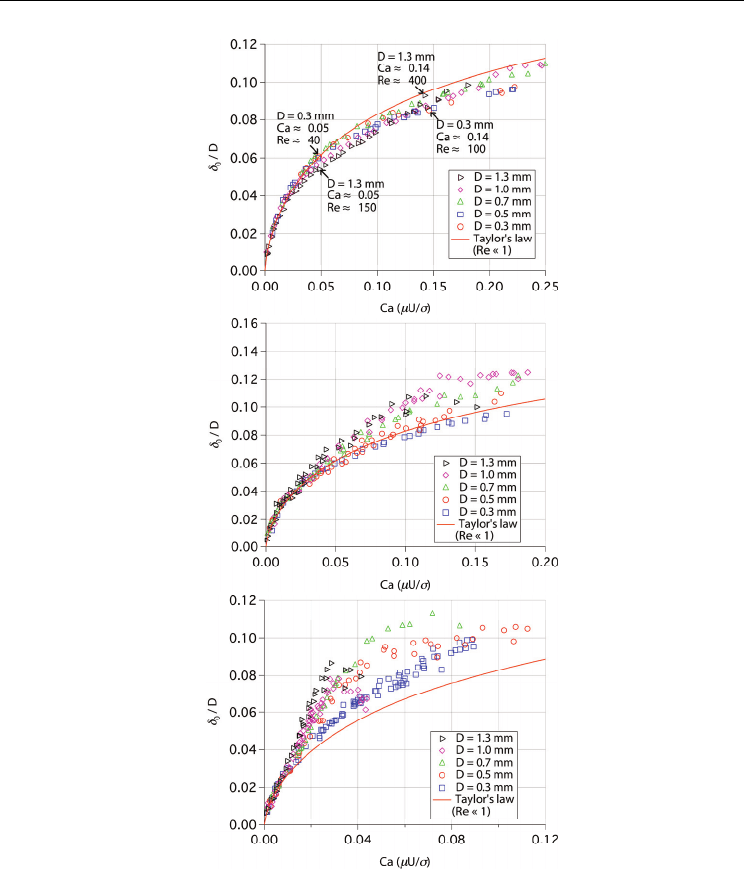
Liquid Film Thickness in Micro-Scale Two-Phase Flow
349
(a)
(b)
(c)
Fig. 8. Initial liquid film thickness in steady circular tubes. (a) FC-40, (b) ethanol and
(c) water
Figure 8 (b) shows initial liquid film thickness for ethanol. Again, initial liquid film thickness
measured from the tube side is shown. Reynolds number of ethanol is about 6 times larger
than that of FC-40, as already shown in Fig. 6. Therefore, the effect of inertial force becomes
stronger for ethanol than for FC-40. At Ca < 0.02, dimensionless initial liquid film
thicknesses in five different tubes become nearly identical with the Taylor’s law as in the
case of FC-40. However, the deviation from Taylor’s law starts from lower capillary number
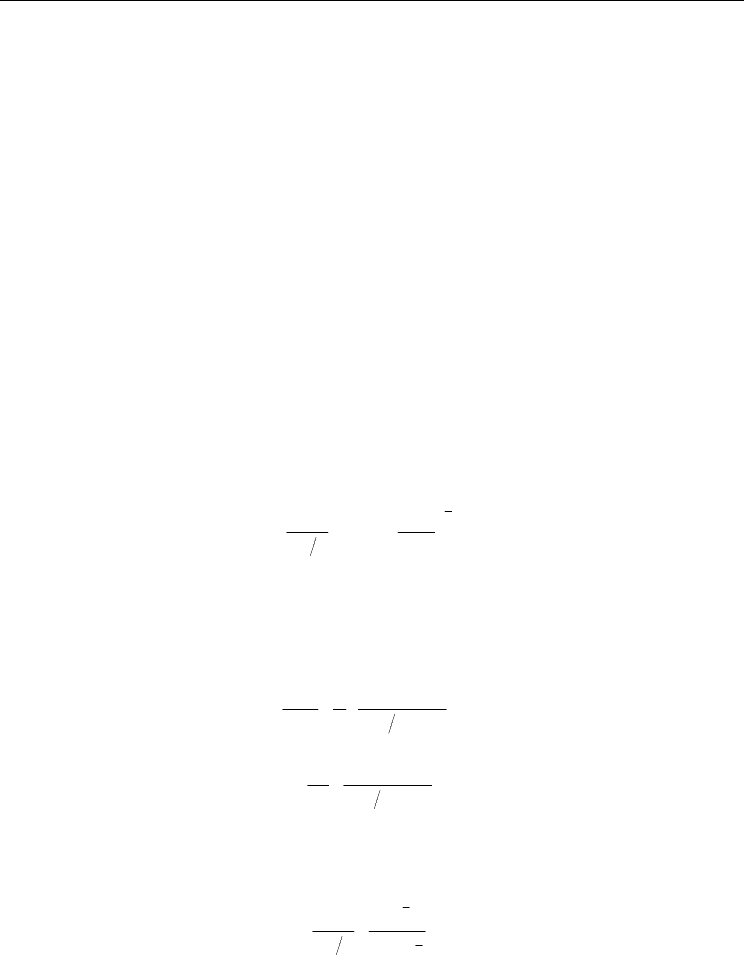
Two Phase Flow, Phase Change and Numerical Modeling
350
for the ethanol case. At large capillary numbers, all data are larger than the Taylor’s law.
Inertial force is often neglected in micro two phase flows, but it is clear that the inertial force
should be considered from this Reynolds number range. In Fig. 8 (b), dimensionless initial
liquid film thickness in 1.3 mm inner diameter tube shows different trend at Ca > 0.12,
showing some scattering. Reynolds number of ethanol in 1.3 mm inner diameter tube
becomes Re ≈ 2000 at Ca ≈ 0.12. Thus, this different trend is considered to be the effect of
flow transition from laminar to turbulent.
Figure 8 (c) shows initial liquid film thickness for water. At Re > 2000, initial liquid film
thickness does not increase but remains nearly constant with some scattering. This tendency
is found again when Reynolds number exceeds approximately Re ≈ 2000. The deviation
from Taylor’s law starts from the lower capillary number than FC-40 and ethanol.
Dimensionless initial liquid film thickness of water shows much larger values than that of
ethanol and Taylor’s law. In the case of 1.3 mm inner diameter tube, dimensionless initial
liquid film thickness is nearly 2 times larger than the Taylor’s law at Ca ≈ 0.03. It is clearly
seen that inertial force has a strong effect on liquid film thickness even in the Reynolds
number range of Re < 2000.
3.1.2 Scaling analysis for circular tubes
Bretherton (1961) proposed a theoretical correlation for the liquid film thickness with
lubrication equations as follows:
U
D
2
3
0
h
3
0.643
2
δμ
σ
=
. (12)
Aussillous and Quere (2000) modified Bretherton’s analysis, and replaced the bubble nose
curvature κ = 1/(D
h
/2) with κ = 1/{(D
h
/2)-δ
0
}. In their analysis, the momentum balance and
the curvature matching between the bubble nose and the transition region are expressed as
follows:
()
U
D
2
h0
1
~
2
ρσ
λλ δ
−
, (13)
()
D
0
2
h0
~
2
δσ
λδ
−
. (14)
where
λ
is the length of the transition region as shown in Fig. 9. Eliminating
λ
from Eqs. (13)
and (14), they obtained following relation for dimensionless liquid film thickness:
Ca
D
Ca
2
3
0
2
h
3
~
2
1
δ
+
. (15)
In Eq. (15), dimensionless liquid film thickness asymptotes to a finite value due to the term
Ca
2/3
in the denominator. Based on Eq. (15), Taylor’s experimental data was fitted as Eq. (11).
If inertial force effect is taken into account, the momentum balance (13) should be expressed
as follows:
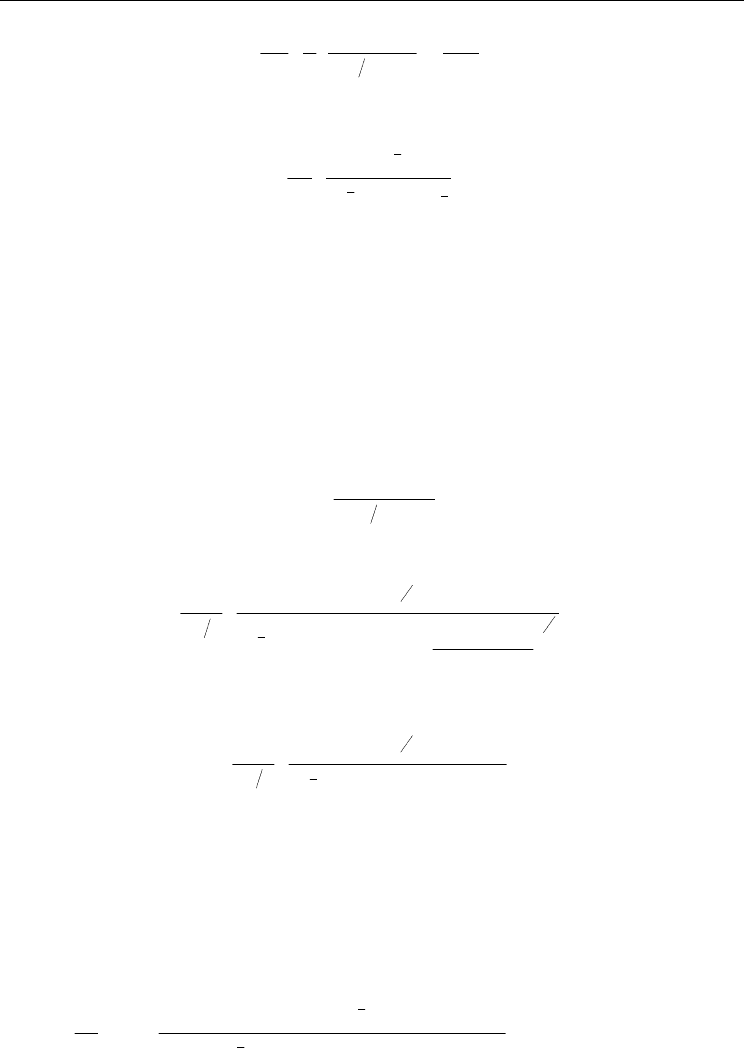
Liquid Film Thickness in Micro-Scale Two-Phase Flow
351
()
UU
D
2
2
0h0
1
~
2
μσρ
δλ δ λ
−
−
, (16)
Using Eqs. (14) and (16), we can obtain the relation for initial liquid film thickness δ
0
/D
h
as:
()
Ca
D
Ca We
2
3
0
2
2
h
3
3
~
1
δ
′
+−
, (17)
where Weber number is defined as We’ = ρU
2
((D
h
/2)-δ
0
)/σ. Equation (17) is always larger
than Eq. (15) because the sign in front of Weber number is negative. Therefore, Eq. (17) can
express the increase of the liquid film thickness with Weber number. In addition, Heil (2001)
reported that inertial force makes the bubble nose slender and increases the bubble nose
curvature at finite Reynolds numbers. It is also reported in Edvinsson & Irandoust (1996)
and Kreutzer et al. (2005) that the curvature of bubble nose increases with Reynolds and
capillary numbers. This implies that curvature term κ = 1/{(D
h
/2)-δ
0
} in momentum
equation (16) should be larger for larger Reynolds and capillary numbers. We assume that
this curvature change can be expressed by adding a modification function of Reynolds and
capillary numbers to the original curvature term κ = 1/{(D
h
/2)-δ
0
} as:
()
()
f
Ca
D
h0
1Re,
2
κ
δ
+
=
−
, (18)
Substituting Eq. (18) into Eqs. (14) and (16), we obtain:
()
()
()
Ca
D
We
Ca f Ca
fCa
2
3
0
2
3
2
h
3
~
2
1Re, 1
1Re,
δ
′
++ −
+
. (19)
If all the terms with Re, Ca and We can be assumed to be small, we may simplify Eq. (19) as:
()
()
Ca
D
Ca f Ca g We
2
3
0
2
h
3
~
2
1Re,
δ
′
++ −
. (20)
In the denominator of Eq. (20), f (Re, Ca) term corresponds to the curvature change of bubble
nose and contributes to reduce liquid film thickness. On the other hand, when the inertial
effect increases, g(We’) term contributes to increase the liquid film thickness due to the
momentum balance. Weber number in Eq. (17) includes initial liquid film thickness δ
0
in its
definition. Therefore, in order to simplify the correlation, Weber number is redefined as
We = ρU
2
D
h
/σ. The experimental data is finally correlated by least linear square fitting in the
form as:
h
Ca
D
Ca Ca We
2
3
0
2
0.672 0.589 0.629
3
steady
0.670
1 3.13 0.504 Re 0.352
δ
=
++ −
(Ca < 0.3, Re < 2000) , (21)
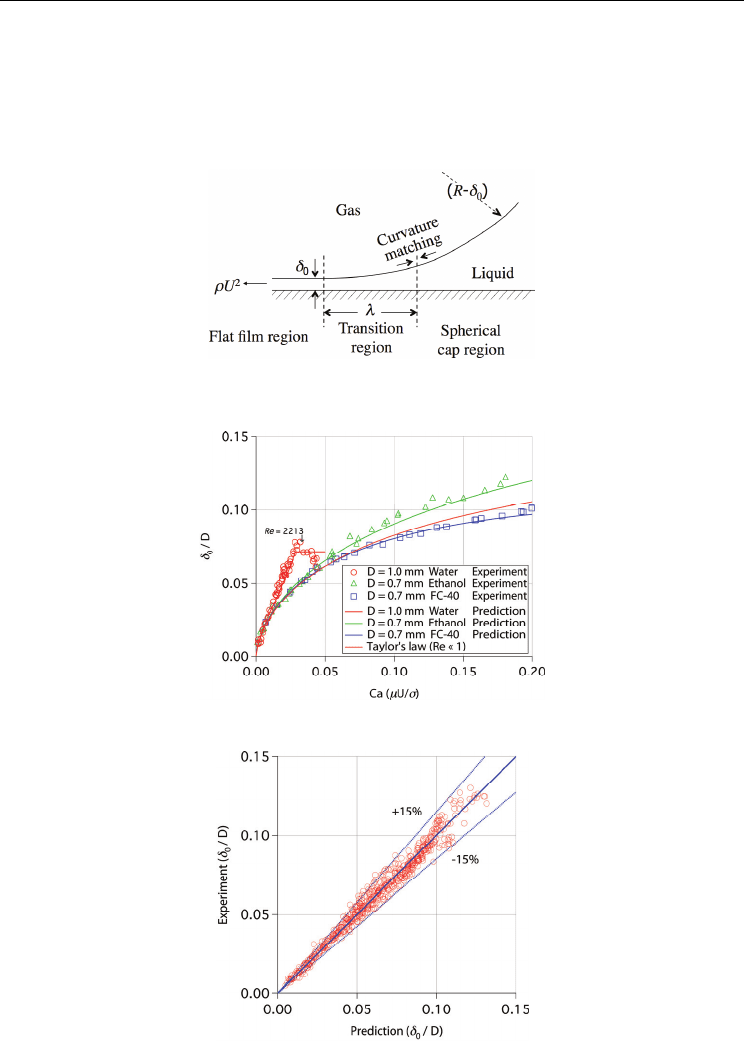
Two Phase Flow, Phase Change and Numerical Modeling
352
where Ca = μU/σ and Re = ρUD
h
/μ and We = ρU
2
D
h
/σ. As capillary number approaches
zero, Eq. (21) should follow Talors’s law (11), so the coefficient in the numerator is taken as
0.670. If Reynolds number becomes larger than 2000, initial liquid film thickness is fixed at a
constant value at Re = 2000. Figures 10 and 11 show the comparison between the
experimental data and the prediction of Eq. (20). As shown in Fig. 11, the present correlation
can predict δ
0
within the range of ±15% accuracy.
Fig. 9. Schematic diagram of the force balance in bubble nose, transition and flat film regions
in circular tube slug flow
Fig. 10. Predicted initial liquid film thickness δ
0
by Eq. (21)
Fig. 11. Comparison between predicted and measured initial liquid film thicknesses δ
0

Liquid Film Thickness in Micro-Scale Two-Phase Flow
353
3.2 Steady square tube flow
3.2.1 Dimensionless bubble radii
Dimensionless bubble radii R
center
and R
corner
are the common parameters used in square
channels:
R
D
0_center
center
h
2
1
δ
=− , (22)
R
D
0_corner
corner
h
2
2
δ
=− . (23)
It should be noted that initial liquid film thickness at the corner δ
0_corner
in Eq. (23) is defined
as a distance between air-liquid interface and the corner of circumscribed square which is
shown as a white line in Fig. 2(b). When initial liquid film thickness at the channel center
δ
0_center
is zero, R
center
becomes unity. If the interface shape is axisymmetric, R
center
becomes
identical to R
corner
.
Figure 12(a) shows R
center
and R
corner
against capillary number for FC-40. The solid lines in
Fig. 12 are the numerical simulation results reported by Hazel & Heil (2002). In their
simulation, inertial force term was neglected, and thus it can be considered as the low
Reynolds number limit. Center radius R
center
is almost unity at capillary number less than
0.03. Thus, interface shape is non-axisymmetric for Ca < 0.03. For Ca > 0.03, R
center
becomes
nearly identical to R
corner
, and the interface shape becomes axisymmetric. In Fig. 12,
measured bubble radii in D
h
= 0.3 and 0.5 mm channels are almost identical, and they are
larger than the numerical simulation result. On the other hand, the bubble radii in D
h
= 1.0
mm channel are smaller than those for the smaller channels. As capillary number
approaches zero, liquid film thickness in a micro circular tube becomes zero. In micro
square tubes, liquid film δ
0_corner
still remains at the channel corner even at zero capillary
number limit. Corner radius R
corner
reaches an asymptotic value smaller than 2 as
investigated in Wong et al.’s numerical study (1995a, b). This asymptotic value will be
discussed in the next section.
Figure 12(b) shows R
center
and R
corner
for ethanol. Similar to the trend found in FC-40
experiment, R
center
is almost unity at low capillary number. Most of the experimental data
are smaller than the numerical result. Transition capillary number, which is defined as the
capillary number when bubble shape changes from non-axisymmetric to axisymmetric,
becomes smaller as D
h
increases. For D
h
= 1.0 mm square tube, R
center
is almost identical to
R
corner
beyond this transition capillary number. However, for D
h
= 0.3 and 0.5 mm tubes,
R
center
is smaller than R
corner
even at large capillary numbers. At the same capillary number,
both R
center
and R
corner
decrease as Reynolds number increases. For Ca > 0.17, R
center
and
R
corner
in D
h
= 1.0 mm square tube becomes nearly constant. It is considered that this trend is
attributed to laminar-turbulent transition. At Ca ≈ 0.17, Reynolds number of ethanol in D
h
=
1.0 mm channel becomes nearly Re ≈ 2000 as indicated in Fig. 12(b).
Center and coner radii, R
center
and R
corner
, for water are shown in Fig. 12(c). Center radius
R
center
is again almost unity at low capillary number. Transition capillary numbers for D
h
=
0.3, 0.5 and 1.0 mm square channels are Ca = 0.025, 0.2 and 0.014, respectively. These values
are much smaller than those for ethanol and FC-40. Due to the strong inertial effect, bubble
diameter of the water experiment is much smaller than those of other fluids and the
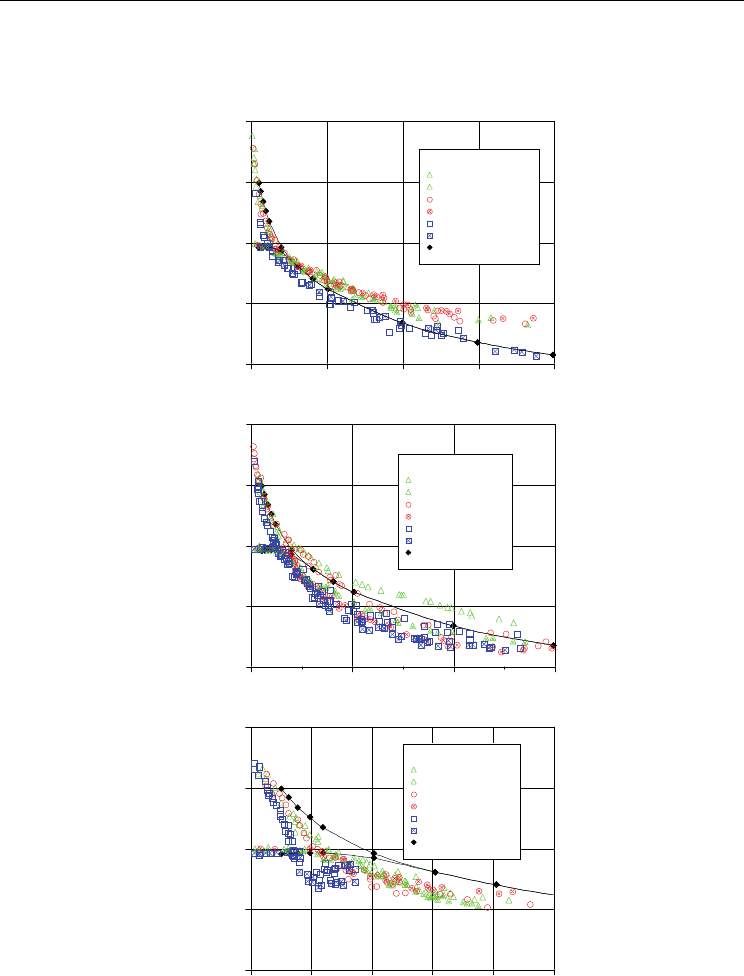
Two Phase Flow, Phase Change and Numerical Modeling
354
numerical results. It is confirmed that inertial effect must be considered also in micro square
tubes. Bubble diameter becomes nearly constant again for Re > 2000. Data points at Re ≈ 2000
are indicated in Fig. 12(c).
(a)
1.2
1.1
1.0
0.9
0.8
R
center
, R
corner
0.40.30.20.10.0
Ca (
μ
U/
σ
)
Square channel, FC-40
D
h
= 0.3 mm, R
corner
D
h
= 0.3 mm, R
center
D
h
= 0.5 mm, R
corner
D
h
= 0.5 mm, R
center
D
h
= 1.0 mm, R
corner
D
h
= 1.0 mm, R
center
Numerical simulation
(Hazel and Heil, 2002)
x
(b)
1.2
1.1
1.0
0.9
0.8
R
center
, R
corner
0.300.200.100.00
Ca (
μ
U/
σ
)
Square channel, Ethanol
D
h
= 0.3 mm, R
corner
D
h
= 0.3 mm, R
center
D
h
= 0.5 mm, R
corner
D
h
= 0.5 mm, R
center
D
h
= 1.0 mm, R
corner
D
h
= 1.0 mm, R
center
Numerical simulation
(Hazel and Heil, 2002)
↑
Re = 2199
x
(c)
1.2
1.1
1.0
0.9
0.8
R
center
, R
corner
0.100.080.060.040.020.00
Ca (
μ
U/
σ
)
Square channel, Water
D
h
= 0.3 mm, R
corner
D
h
= 0.3 mm, R
center
D
h
= 0.5 mm, R
corner
D
h
= 0.5 mm, R
center
D
h
= 1.0 mm, R
corner
D
h
= 1.0 mm, R
center
Numerical simulation
(Hazel and Heil, 2002)
↑
Re = 2033
↑
Re = 2417
x
Fig. 12. Dimensionless center and coner radii, R
center
and R
corner
, in steady square tubes.
(a) FC-40, (b) ethanol and (c) water
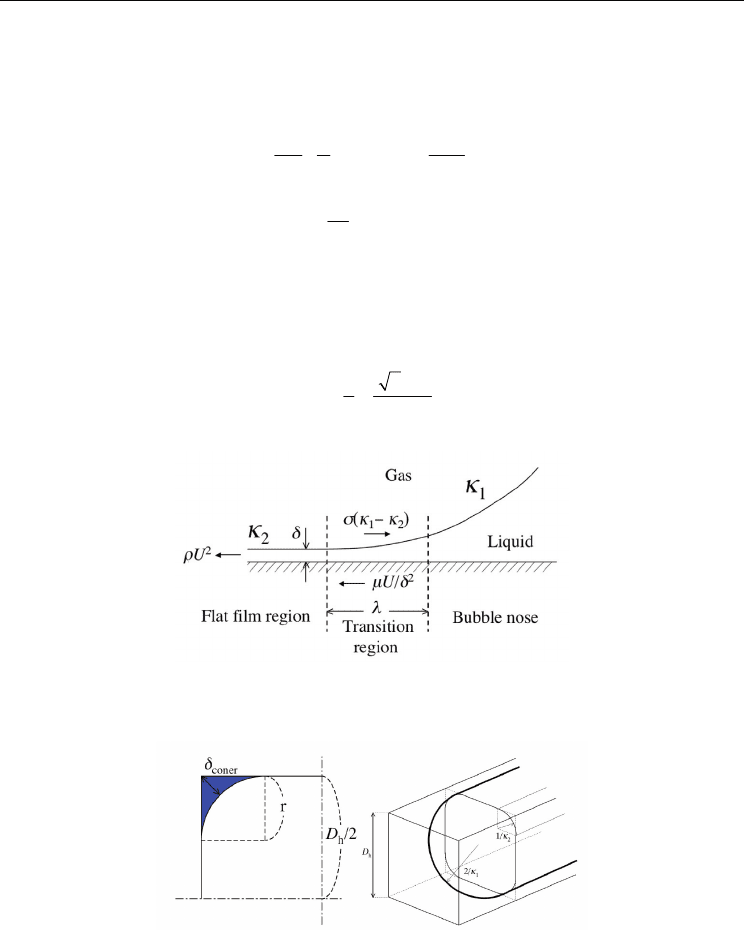
Liquid Film Thickness in Micro-Scale Two-Phase Flow
355
3.2.2 Scaling analysis for square tubes
Figure 13 shows the schematic diagram of the force balance in the transition region in
square tubes. Momentum equation and curvature matching in the transition region are
expressed as follows:
()
UU
2
12
2
0
1
~
μρ
σκ κ
δλ λ
−− , (24)
0
12
2
~
δ
κκ
λ
−
, (25)
where,
κ
1
and
κ
2
are the curvatures of bubble nose and flat film region, respectively. In the
present experiment,
δ
0_corner
does not become zero but takes a certain value as Ca → 0. Figure
14 shows the schematic diagram of the interface shape at Ca → 0. In Fig. 14, air-liquid
interface is assumed as an arc with radius r. Then,
κ
2
can be expressed as follows:
r
2
0_corner
121
κ
δ
−
== . (26)
Fig. 13. Schematic diagram of the force balance in bubble nose, transition and flat film
regions in square
Fig. 14. Schematic diagram of the gas liquid interface profile at Ca → 0
If bubble nose is assumed to be a hemisphere of radius D
h
/2, the curvature at bubble nose
becomes
κ
1
= 2/(D
h
/2). This curvature
κ
1
should be larger than the curvature of the flat film
region
κ
2
according to the momentum balance, i.e.
12
κκ
≥ . From this restraint, the relation of
D
h
and
δ
0_corner
is expressed as follows:
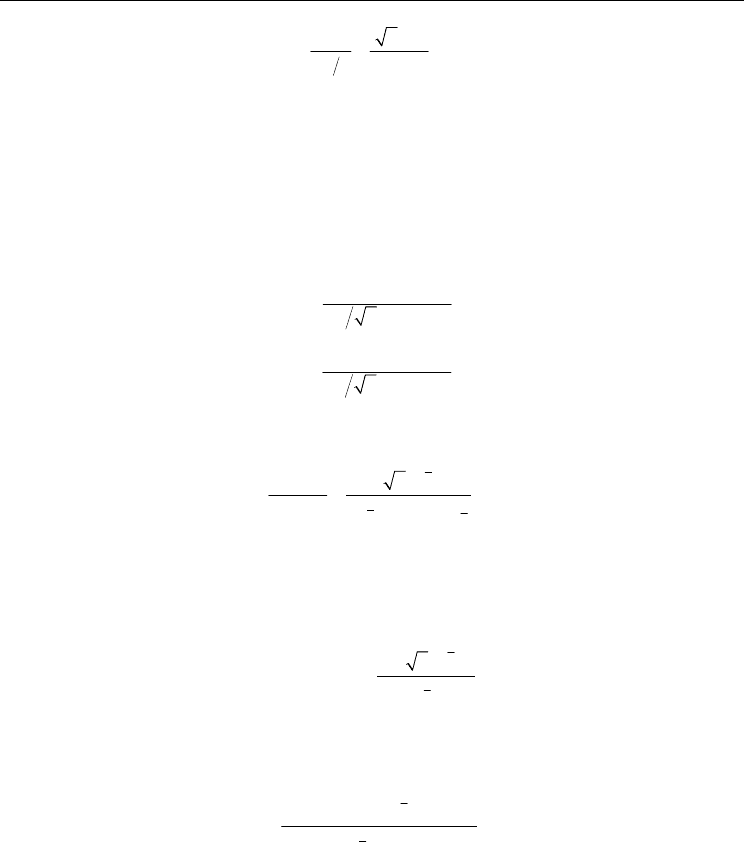
Two Phase Flow, Phase Change and Numerical Modeling
356
h
D
0_corner
221
2
δ
−
≥ . (27)
From Eqs. (23) and (27), the maximum value of R
corner
can be determined as follows:
R
corner
1.171≤ . (28)
From Fig. 12, the interface shape becomes nearly axisymmetric as capillary number
increases. Here, bubble is simply assumed to be hemispherical at bubble nose and
cylindrical at the flat film region, i.e. R
corner
= R
center
. Under such assumption, the curvatures
κ
1
and
κ
2
in Eqs. (24) and (25) can be rewritten as follows:
h
D
1
0_corner
2
2
κ
δ
=
−
, (29)
h
D
2
0_corner
1
2
κ
δ
=
−
. (30)
We can obtain the relation for
δ
0_corner
from Eqs. (24), (25), (29) and (30) as:
()
h
Ca
D
Ca We
2
3
0_corner
2
2
3
3
2
1
δ
≈
′
+−
, (31)
where We′ is the Weber number which includes
δ
0_corner
in its definition. Thus, We′ is
replaced by We =
ρ
U
2
D
h
/
σ
for simplicity. The denominator of R.H.S in Eq. (31) is also
simplified with Taylor expansion. From Eqs. (28) and (31), R
corner
is written as follows:
Ca
R
Ca We
2
3
corner
2
3
22
~1.171
1
−
+−
. (32)
The experimental correlation for R
corner
is obtained by optimizing the coefficients and
exponents in Eq. (32) with the least linear square method as follows:
Ca
R
Ca We
2
3
corner
2
0.215
3
2.43
1.171
1 7.28 0.255
=−
+−
(Re < 2000) , (33)
()
()
R
R
RR
corner
center
corner corner
11
1
>
≅
≤
(Re < 2000) . (34)
From Eq. (34), R
center
becomes unity at small capillary number. However,
δ
0_center
still has a
finite value even at low Ca, which means that R
center
should not physically reach unity.
Further investigation is required for the accurate scaling of
δ
0_center
and R
center
at low Ca. As
capillary number increases, interface shape becomes nearly axisymmetric and R
center
becomes identical to R
corner
. As capillary number approaches zero, R
corner
takes an asymptotic
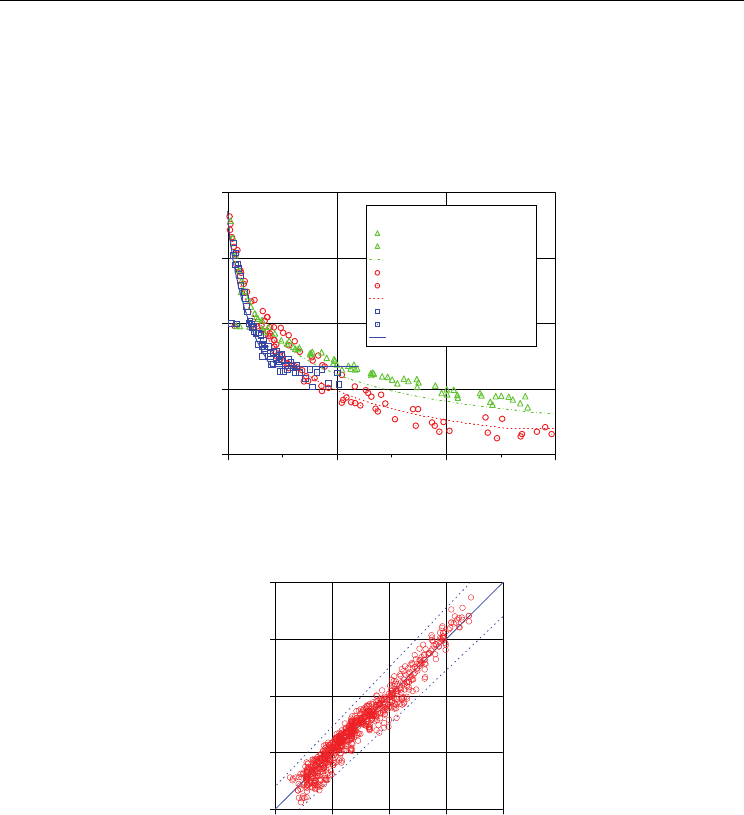
Liquid Film Thickness in Micro-Scale Two-Phase Flow
357
value of 1.171. If Reynolds number becomes larger than 2000, R
corner
becomes constant due
to flow transition from laminar to turbulent. Then, capillary and Weber numbers at Re =
2000 should be substituted in Eq. (33). Figure 15 shows the comparison between the
experimental data and the predicted results with Eqs. (33) and (34). As shown in Fig. 16, the
present correlation can predict dimensionless bubble diameters within the range of ±5 %
accuracy.
1.2
1.1
1.0
0.9
0.8
R
center
, R
corner
0.300.200.100.00
Ca (
μ
U/
σ
)
Square channel
FC-40, D
h
= 0.5 mm, R
corner
FC-40, D
h
= 0.5 mm, R
center
FC-40, D
h
= 0.5 mm, Prediction
Ethanol, D
h
= 0.5 mm, R
corner
Ethanol, D
h
= 0.5 mm, R
center
Ethanol, D
h
= 0.5 mm, Prediction
Water, D
h
= 0.5 mm, R
corner
Water, D
h
= 0.5 mm, R
center
Water, D
h
= 0.5 mm, Prediction
Fig. 15. Predicted bubble diameter in D
h
= 0.5 mm square tube
1.2
1.1
1.0
0.9
0.8
R
corner
, Experiment
1.21.11.00.90.8
R
corner
, Prediction
+5 %
-5 %
Fig. 16. Comparison between predicted and measured bubble radii
3.3 Steady flow in high aspect ratio rectangular tubes
For high aspect ratio rectangular tubes, interferometer as well as laser confocal displacement
meter are used to measure liquid film thickness (Han et al. 2011). Figure 17 shows the initial
liquid film thicknesses obtained by interferometer and laser confocal displacement meter. In
the case of interferometer, initial liquid film thickness is calculated by counting the number
of fringes from the neighbouring images along the flow direction. In Fig. 17, error bars on
the interferometer data indicate uncertainty of 95 % confidence. Both results show good
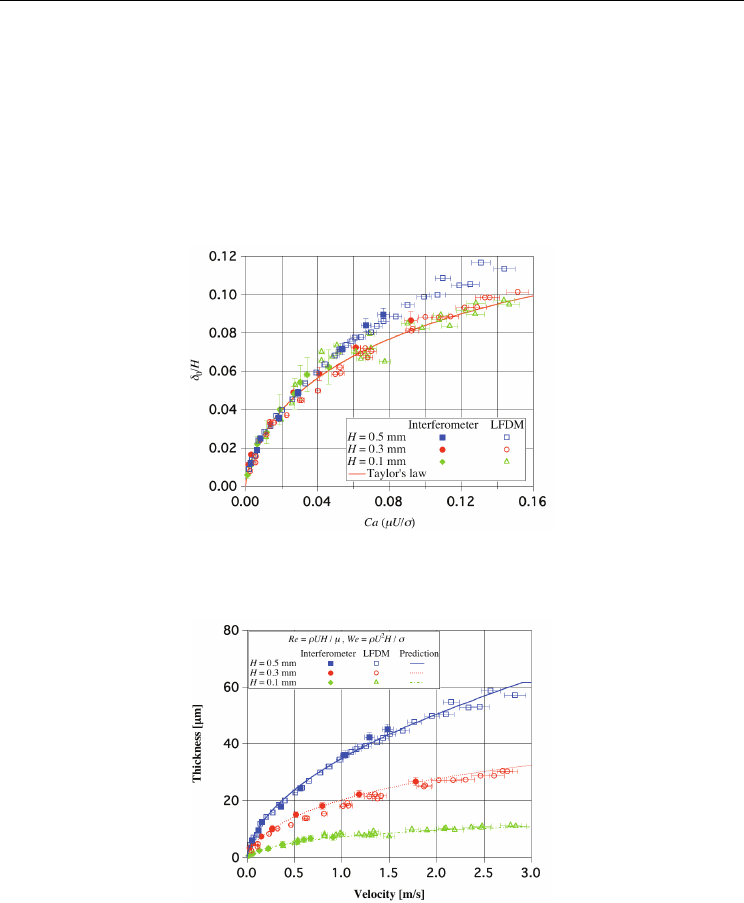
Two Phase Flow, Phase Change and Numerical Modeling
358
agreement, which proves that both methods are effective to measure liquid film thickness
very accurately.
From the analogy between flows in circular tubes and parallel plates, it is demonstrated that
dimensionless expression of liquid film thickness in parallel plates takes the same form as
Eq. (19) if tube diameter D
h
is replaced by channel height H (Han, et al. 2011). Figure 18
shows the comparison between experimental data and predicted values with Eq. (21) using
hydraulic diameter as the characteristic length for Reynolds and Weber numbers. As can be
seen from the figure, Eq (21) can predict initial liquid film thickness in high aspect ratio
rectangular tube remarkably well.
Fig. 17. Measured initial liquid film thickness in high aspect ration rectangular tubes using
interferometer and laser confocal displacement meter
Fig. 18. Comparison between measured and predicted initial liquid film thicknesses by Eq.
(21) in high aspect ratio rectangular tubes
3.4 Accelerated circular tube flow
3.4.1 Acceleration experiment
In order to investigate the effect of flow acceleration on the liquid film thickness,
measurement points are positioned at Z = 5, 10 and 20 mm away from the initial air-liquid
